Digital Poster
Resting-State fMRI in Humans in Health
Joint Annual Meeting ISMRM-ESMRMB & ISMRT 31st Annual Meeting • 07-12 May 2022 • London, UK

| Computer # | ||||
|---|---|---|---|---|
2469 |
1 | Neural correlates of fluid intelligence identified by empirical neural network-based brain states
Robert Englert1, Balint Kincses2, Giuseppe Gallitto2, Raviteja Kotikalapudi1, Kevin Hoffschlag1, and Tamas Spisak1
1Institute of Diagnostic and Interventional Radiology and Neuroradiology, University Hospital Essen, Germany, Essen, Germany, 2Department of Neurology, University Hospital Essen, Germany, Essen, Germany
We propose a novel method which considers the functional connectome as an already-trained, empirical continuous Hopfield Network, to extract brain states from a population connectome to analyze the dynamics of the so-called attractor states on the subject level. We apply our method to the Human Connectome Project dataset, and we could show, that the mean activation of the participants during different states is a significant predictor of fluid intelligence.
|
||
2470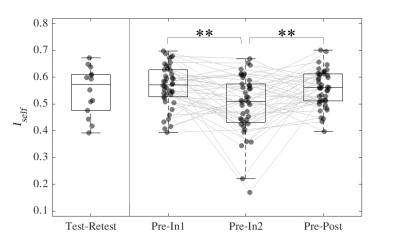 |
2 | Longitudinal changes in fMRI brain fingerprints of asymptomatic high school American football athletes
Bradley Fitzgerald1, Sumra Bari2, Nicole Vike2, Roy J. Lycke3, Joshua D. Auger4, Eric Nauman5, Joaquin Goni6,7, and Thomas M. Talavage1,8
1Elmore Family School of Electrical and Computer Engineering, Purdue University, West Lafayette, IN, United States, 2Warren Wright Adolescent Center, Department of Psychiatry and Behavioral Sciences, Feinberg School of Medicine, Northwestern University, Chicago, IL, United States, 3Department of Electrical and Computer Engineering, Rice University, Houton, TX, United States, 4Department of Mechanical Engineering, Boston University, Boston, MA, United States, 5School of Mechanical Engineering, Purdue University, West Lafayette, IN, United States, 6School of Industrial Engineering, Purdue University, West Lafayette, IN, United States, 7Purdue Institute for Integrative Neuroscience, Purdue University, West Lafayette, IN, United States, 8Department of Biomedical Engineering, University of Cincinnati, Cincinnati, OH, United States
We used resting state functional MRI data to investigate whether asymptomatic high school American football athletes undergo functional connectome (FC) changes during exposure to head acceleration events (HAEs). FCs of asymptomatic high school football athletes were shown to undergo significant changes during the season and then return to their pre-season state after the conclusion of collision activities, with changes reflected most profoundly in the somatomotor network. Late-season changes appear to affect all athletes without association with the magnitude of HAEs experienced. These observations demonstrate that participation in American football can cause significant changes in brain functionality without manifesting symptoms.
|
||
2471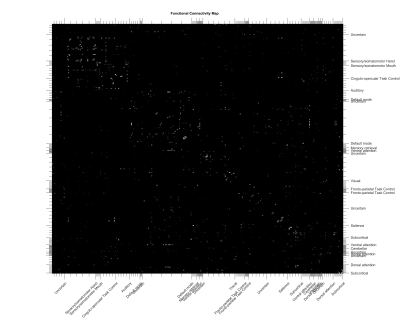 |
3 | Brain functional fingerprinting predicts individual differences in cognition: An AI-based approach
Morteza Esmaeili1,2 and Alireza Salami3,4,5
1Department of Diagnostic Imaging, Akershus University Hospital, Lørenskog, Norway, 2Department of Electrical Engineering and Computer Science, University of Stavanger, Stavanger, Norway, 3Wallenberg Center for Molecular Medicine (WCMM), Umeå University, Umeå, Sweden, 4Department of Integrative Medical Biology, Umeå University, Umeå, Sweden, 5Aging Research Center, Karolinska Institute and Stockholm University, Solna, Sweden
Machine learning approaches provide convenient autonomous object classification in medical imaging domains. This study examines the utility of convolutional neural networks in predicting individual differences in cognition from the resting-state functional connectome. We observed significant contributions from the subcortical areas (including hippocampus) and their interactions with the cortical default mode network to the training progress. Our results demonstrate that an AI-based model can predict an individual's EM scores.
|
||
2472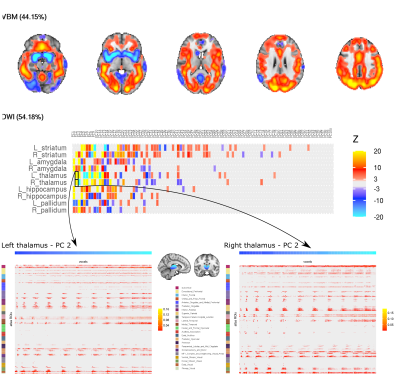 |
4 | Linking functional and structural brain organisation with behaviour in healthy adults
Natalie Forde1, Alberto Llera1, Jan Buitelaar1, and Christian Beckmann1
1Radboud University Medical Centre, Donders Institute for Brain, Cognition and Behaviour, Nijmegen, Netherlands
Understanding brain-behaviour correlates is challenging. Multimodal approaches increase the sensitivity to brain-behaviour relationships. Here we integrated grey matter density maps, structural connectivity metrics and functional connectopic (gradient) maps from 676 participants of the HCP, with the hypothesis that these more advanced measures of both structural and functional organisation would improve sensitivity to brain-behaviour associations. Our results show 1 component significantly associated with various behavioural measures including multiple measures of alcohol use. This component was composed of structural modalities. There was little shared variance between structural measures and functional gradients across the components.
|
||
2473 |
5 | Age and sex contributions to variance in resting state fMRI (rs-fMRI) temporal complexity analysis
Nicholas Maurice Simard1,2, Dinesh A Kumbhare3,4, Stephan Ulmer5,6, and Michael D Noseworthy1,2,7,8
1Electrical and Computer Engineering, McMaster University, Hamilton, ON, Canada, 2St. Joseph's Healthcare Hamilton, Imaging Research Centre, Hamilton, ON, Canada, 3Toronto Rehabilitation Institute, Toronto, ON, Canada, 4Department of Medicine, University of Toronto, Toronto, ON, Canada, 5neurorad.ch, Zurich, Switzerland, 6Department of Radiology and Neuroradiology, University hospital of Schleswig-Holstein, Kiel, Germany, 7School of Biomedical Engineering, McMaster University, Hamilton, ON, Canada, 8Radiology, McMaster University, Hamilton, ON, Canada
Understanding the process of aging and the differences in sex with regards to large data repositories can help improve the implementation of machine learning and artificial intelligence paradigms in neuroimaging. The following research presents data that identifies a relationship between aging and sex in resting state functional magnetic resonance imaging (rs-fMRI) data. Using over 10,000 age and sex matched healthy controls and performing a homebuilt processing pipeline for rs-fMRI data, significant relationships between aging and reduced temporal complexity (TC) was found (p=0.03058), along with women having a higher TC than men (p=0.000623).
|
||
2474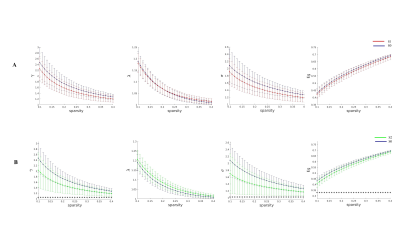 |
6 | Topological organization effects of different theta burst stimulation protocols over precuneus in healthy adults Video Permission Withheld
Xue Li1,2, Xin Xu2, Jiang Xi1, Xiaoqi Huang2,3, and Haoyang Xing1,2
1College of Physics, Sichuan University, Chengdu, China, 2Huaxi MR Research Center (HMRRC), Functional and molecular imaging Key Laboratory of Sichuan Province, Department of Radiology, West China Hospital, Sichuan University,, Chengdu, China, 3Research Unit of Psychoradiology, Chinese Academy of Medical Sciences, Chengdu, China
This study explored the seed-based functional connectivity (FC) and topological organization alteration applied different TBS protocols over precuneus in healthy adults. Increased FC were found in sensorimotor network and insula after application of iTBS or cTBS, decreased FC in left thalamus was found after cTBS. Only cTBS induced significant topological alterations in whole-brain network characterized by small-worldness on FC and functional topology organization, The findings suggested distal effects were complicated and could not been simply summarized as inhibition/facilitation like as proximal rTMS effects. This study may help to elucidate the underlying mechanisms of information transmission through brain function connectivity.
|
||
2475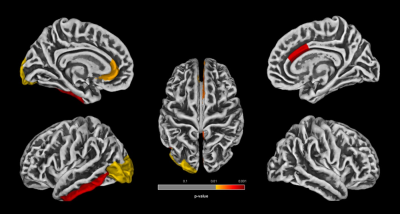 |
7 | Structural and resting-state functional connectivity changes due to chronic noise exposure
S Senthil Kumaran1, A Ankeeta1, Himanshu Singh1, and Nisha Chauhan1
1Department of NMR and MRI Facility, All India Institute of Medical Sciences, New Delhi, India
The effects of cumulative lifetime noise exposure on ascending auditory pathway function in audio metrically normal individuals is explored by sustained and transient fMRI responses and related auditory brainstem response (ABR). The experiment included continuous (scanner noise) and deviant noise (additional pink noise) levels that affected mental workload and auditory/visual attention. Our results exhibited reduced attention and mental workload in central auditory regions in people exposed to higher noise (>85dBA) in comparison with those exposed to lesser noise (<85dBA).
|
||
2476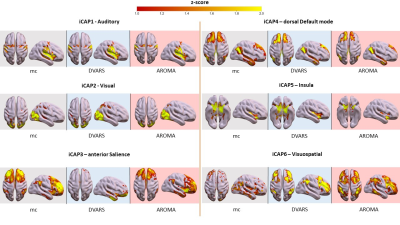 |
8 | Static and dynamic connectivity are differentially affected by head motion: a healthy control and Parkinson’s disease study
Francesca Saviola1, Stefano Tambalo1, Donna Gift Cabalo1, Lisa Novello1, Enrica Pierotti1, Alessandra Dodich1, Costanza Papagno1, Luca Turella1, Dimitri Van De Ville2,3, and Jorge Jovicich1
1University of Trento, Center for Mind/Brain Sciences, Rovereto, Italy, 2Institute of Bioengineering, Center for Neuroprosthetics, Ecole Polytechnique Fédérale de Lausanne (EPFL), Lausanne, Switzerland, 3Department of Radiology and Medical Informatics, University of Geneva (UNIGE), Geneva, Switzerland
An open discussion in functional connectivity (FC) studies is the mitigation of motion-related artifacts. Data-driven denoising such as Independent Component Analysis (ICA) could help in improving the reproducibility of results, however, the definition of pipelines to deal with mild to high motion cases is still controversial. We estimate the effect of different workflows optimized for best-controlling head motion both in healthy and Parkinson’s Disease cohorts. Regardless of baseline head motion level, ICA-based control of motion confounds affects functional connectivity metrics, with non-negligible impact on static connectivity and most severe effects on temporal and spatial features of dynamic functional connectivity measures.
|
||
2477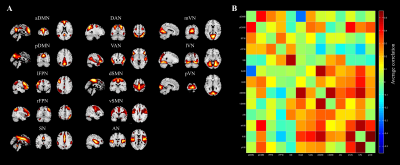 |
9 | Large-Scale Functional Network Connectivity Mediates the Associations of Serum Lipids and Cognitive Function in Patients with Type 2 Diabetes
Wen Zhang1, Jilei Zhang2, and Bing Zhang1
1Drum Tower Hospital, The Affiliated Hospital of Nanjing University Medical School, Nanjing, China, 2Philips Healthcare, Shanghai, China, Shanghai, China
Patients with type 2 diabetes mellitus (T2DM) often have pathologically altered lipid metabolism. Evidence has confirmed that dyslipidemia is linked to cognitive decline. We explored the large-scale functional network connectivity alterations and their potential relationships with serum lipids and cognitive performance in T2DM patients. Our results suggested lower inter and intra-network functional connectivity in T2DM patients and the possibility of improving cognitive function through lipids management.
|
||
2478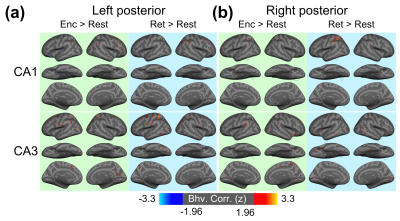 |
10 | Brainwide functional networks associated with hippocampal subfields during memory task using fMRI with 1-mm isotropic resolution
Wei-Tang Chang1,2, Stephanie Langella3, Khoi Huynh2, Min Sung Seo4, Pew-Thian Yap2, Weili Lin2, and Kelly Sullivan Giovanello4
1Radiology, UNIV OF NORTH CAROLINA AT CHAPEL HILL, Chapel Hill, NC, United States, 2BRIC, UNIV OF NORTH CAROLINA AT CHAPEL HILL, Chapel Hill, NC, United States, 3Martinos center, Massachusetts General Hospital, Charlestown, MA, United States, 4Psychology, UNIV OF NORTH CAROLINA AT CHAPEL HILL, Chapel Hill, NC, United States
The interactions between the hippocampal subfields (HCSFs) and cerebral cortex during memory are unclear due to the inherently-low SNR, insufficient spatial resolution or limited spatial coverage. This study is the first fMRI study to examine how the HCSFs interact with the entire cortical surface during the memory encoding and retrieval process by addressing the above-mentioned issues successfully. Our results suggested that 1) the cortical-HCSF functional connectivity (FC) during encoding generally decreased compared to resting, 2) the cortical-HCSF FC increased compared to encoding during retrieval; 3) stronger FC between posterior CA1 and dorsal attention network are correlated with better behavioural performance.
|
||
2479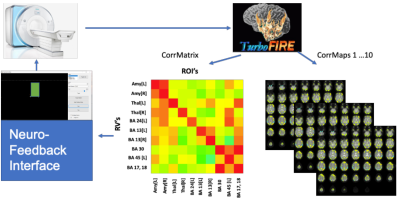 |
11 | Towards Mapping the Resting-State Connectome of the Limbic System in Real-Time with Connectome-based Neurofeedback
Jeff Sharpe1,2, Bruno Sa de la Rocque Guimaraes1,3, and Stefan Posse1,4
1Neurology Department, University of New Mexico, Albuquerque, NM, United States, 2Computer Science Department, University of New Mexico, Albuquerque, NM, United States, 3Nuclear Engineering Department, University of New Mexico, Albuquerque, NM, United States, 4Physics and Astronomy Department, University of New Mexico, Albuquerque, NM, United States
In the present study we develop a real-time seed-based correlation analysis (SBC) pipeline with online regression to compute a connectome fingerprint matrix and characterize the performance of this methodology for quantifying intra- and inter-network connectivity dynamics across major resting state networks (RSNs) in healthy subjects. We assess the association between connectivity in the limbic system and intensity of self-induced mood states with neurofeedback based on the connectome matrix.
|
||
2480 |
12 | Relationship between resting-state fMRI functional connectivity and intracranial EEG band-limited power coupling
Kristina Sabaroedin1,2,3,4, Will Wilson1,5, Daniel J Pittman1,5,6, Paolo Federico1,3,5,6, and Pierre LeVan1,2,3,4
1Hotchkiss Brain Institute, University of Calgary, Calgary, AB, Canada, 2Department of Paediatrics, University of Calgary, Calgary, AB, Canada, 3Department of Radiology, University of Calgary, Calgary, AB, Canada, 4Alberta Children’s Hospital Research Institute, University of Calgary, Calgary, AB, Canada, 5Department of Clinical Neurosciences, University of Calgary, Calgary, AB, Canada, 6Seaman Family MR Research Centre, University of Calgary, Calgary, AB, Canada
Functional connectivity (FC) of resting-state fMRI (rs-fMRI) is a popular method for characterizing brain connectivity. rs-fMRI indirectly measures neuronal fluctuations through blood-oxygenation-level dependent (BOLD) signal and is susceptible to various physiological noise which lead to spurious correlations. We investigated the relationship between rs-fMRI FC and band-limited power (BLP) coupling measured using intracranial EEG (icEEG). Both static and dynamic connectivity analyses revealed a relationship between BOLD FC and icEEG BLP coupling across multiple frequency bands. However, this relationship depends on distance and electrode type. BOLD FC is distinct in fluctuations and spatial variability, suggesting non-neural signal sources in rs-fMRI connectivity.
|
||
2481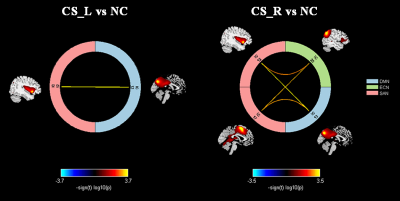 |
13 | Abnormal static and dynamic functional network connectivity in patients with capsular stroke based on the triple-network model.
Yingying Wang1, Caihong Wang1, Peifang Miao1, Ying Wei1, Luobing Wu1, Jingliang Cheng1, and Jingxia Guo2
1The First Affiliated Hospital of Zhengzhou University, Zhengzhou, China, 2GE Healthcare MR Research, Beijing, China
To explore the mechanisms of cognitive impairment and reorganization in patients with left- and right-sided capsular stroke (CS_L, CS_R), we collected resting-state fMRI data from 62 CS_L, 56 CS_R patients and 57 normal controls (NC). Based on the triple-network model [involving the default mode, central executive and salience networks], static (SFNC) and dynamic functional network connectivities (DFNC) were performed to calculate inter-network functional connectivities and estimate temporal features in each state among the three groups. We found more significant SFNC and DFNC changes in CS_R group, suggesting more extensive cognitive impairment and reorganization in CS_R patients than those with CS_L.
|
||
The International Society for Magnetic Resonance in Medicine is accredited by the Accreditation Council for Continuing Medical Education to provide continuing medical education for physicians.